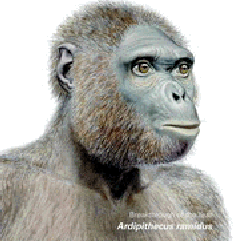|
|
|
|
|
|
|
News & Views item - December 2009 |
![]() Science's Breakthrough for 2009 Ardipithecus ramidus.
(December 18, 2009)
Science's Breakthrough for 2009 Ardipithecus ramidus.
(December 18, 2009)
Ann Gibbons writing in the December 18, 2009 issue of Science introduces the journal's scientific breakthrough of the year writing:
A rare 4.4-million-year-old skeleton has drawn back the curtain of
time to reveal the surprising body plan and ecology of our earliest ancestors.

 Only
a handful of individual fossils have become known as central characters in the
story of human evolution. They include the first ancient human skeleton ever
found, a Neandertal from Germany's Neander Valley; the Taung child from South
Africa, which in 1924 showed for the first time that human ancestors lived in
Africa; and the famous Lucy, whose partial skeleton further revealed a key stage
in our evolution. In 2009, this small cast got a new member: Ardi, now the
oldest known skeleton of a putative human ancestor, found in the Afar Depression
of Ethiopia with parts of at least 35 other individuals of her species.
Only
a handful of individual fossils have become known as central characters in the
story of human evolution. They include the first ancient human skeleton ever
found, a Neandertal from Germany's Neander Valley; the Taung child from South
Africa, which in 1924 showed for the first time that human ancestors lived in
Africa; and the famous Lucy, whose partial skeleton further revealed a key stage
in our evolution. In 2009, this small cast got a new member: Ardi, now the
oldest known skeleton of a putative human ancestor, found in the Afar Depression
of Ethiopia with parts of at least 35 other individuals of her species.
An engaging video featuring scientists C. Owen Lovejoy, Tim White, Giday WoldeGabriel, Yohannes Haile-Selassie, as well as Science contributing correspondent Ann Gibbons, and commentary by paleoanthropologist Andrew Hill. It gives an excellent overview of the work of 15 years of "highly collaborative research".